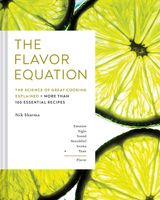Advertisement
Tastes and Receptors
By Nik Sharma
Published 2020
Based on their responses, taste can fall into three categories for most animals: pleasant, unpleasant, and indifferent. However, humans can differentiate taste among five basic, distinct categories: saltiness, sourness, sweetness, bitterness, and savoriness (umami).
The fiery heat that you feel on your tongue when you eat chillies is technically not a taste but rather, as we will see, a response to pain. There are some cultural differences in how tastes are classified; in ancient Ayurvedic texts, pungency (hot) and astringency (but not umami) are considered types of taste. Pomegranate juice, though sour and sweet, can create a sensation of dryness in the mouth; this is astringency. More recently, a growing body of research supports the existence of receptors that detect a sixth taste—oleogustus, or the taste of fat, which I’ve given its own chapter (see Richness).

